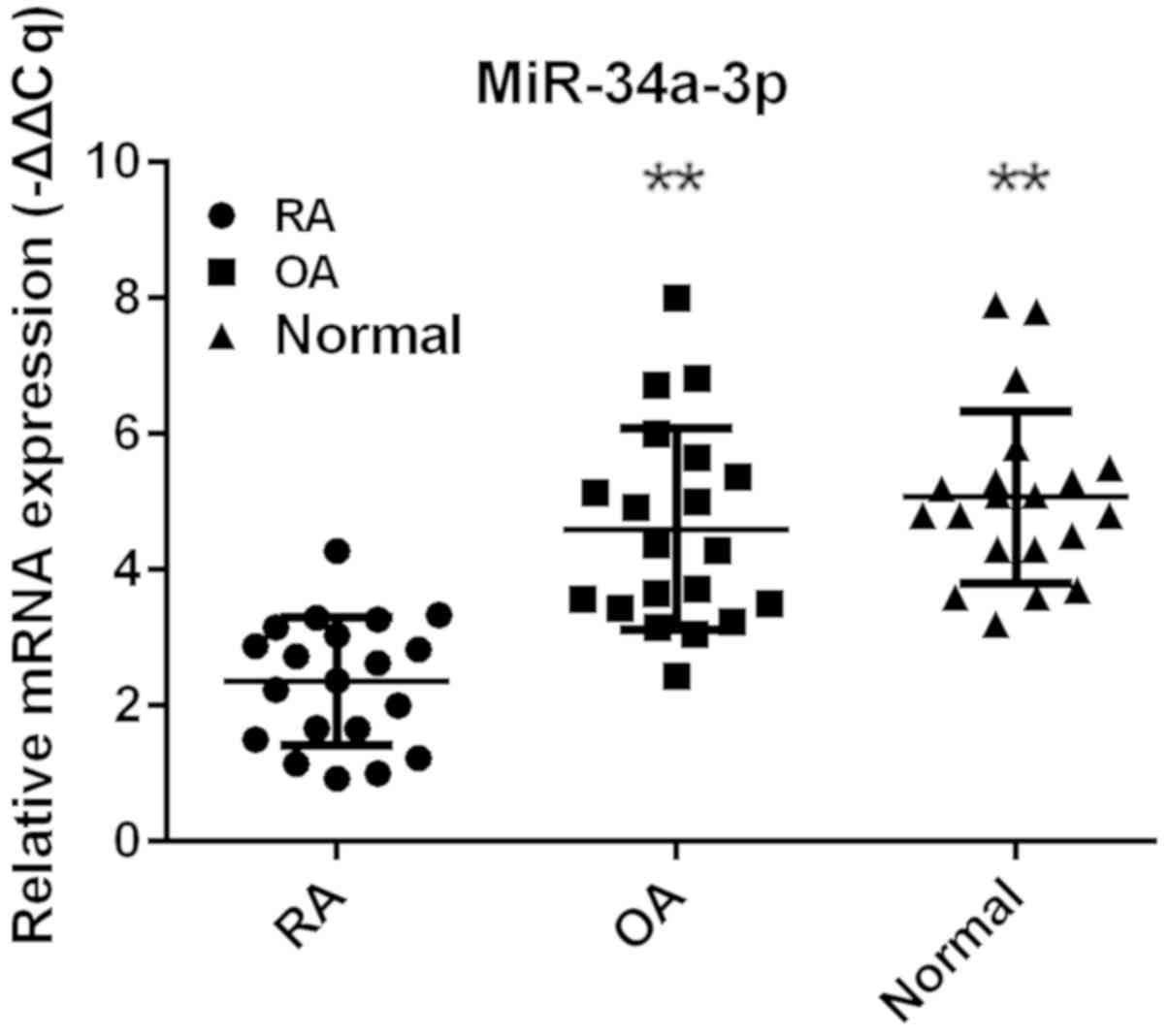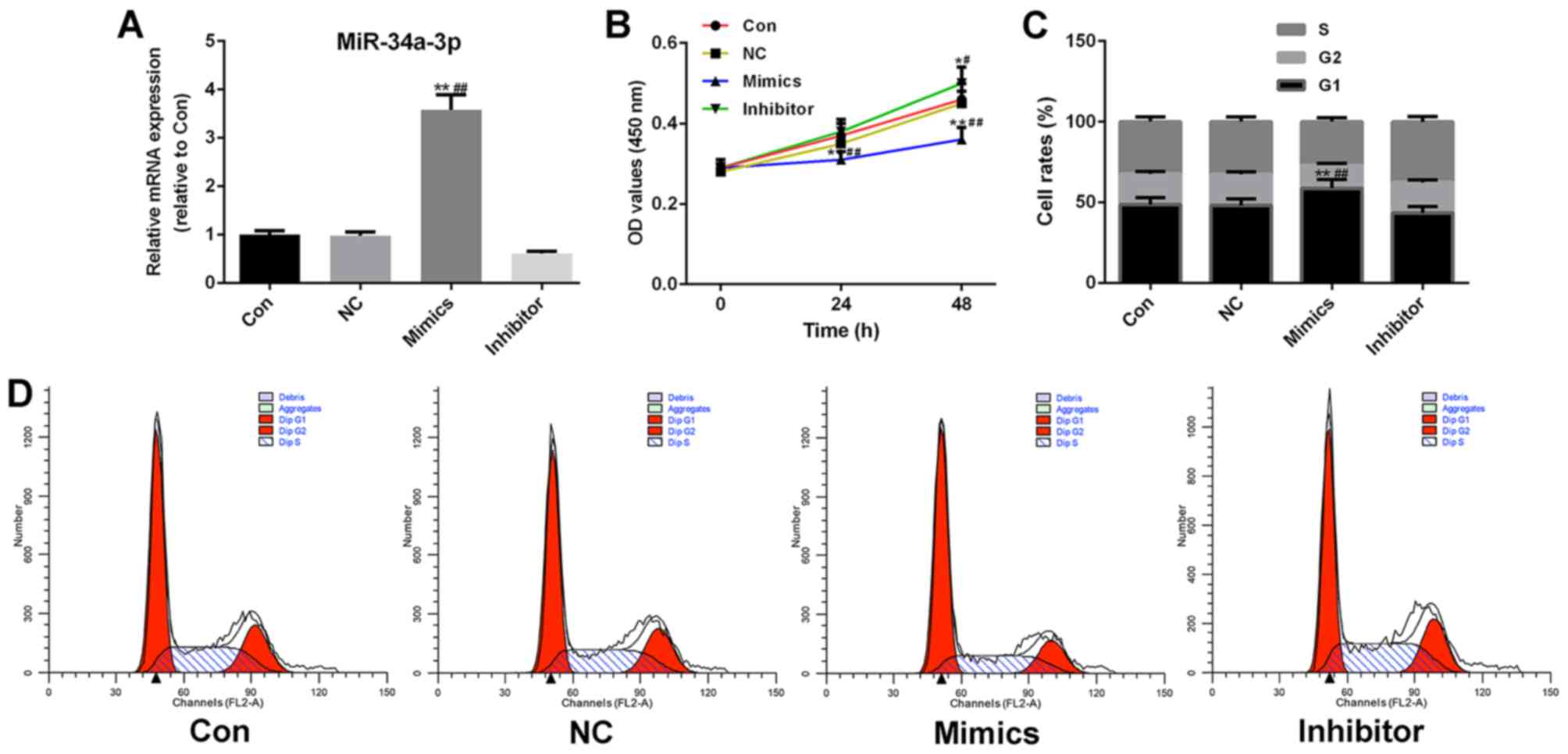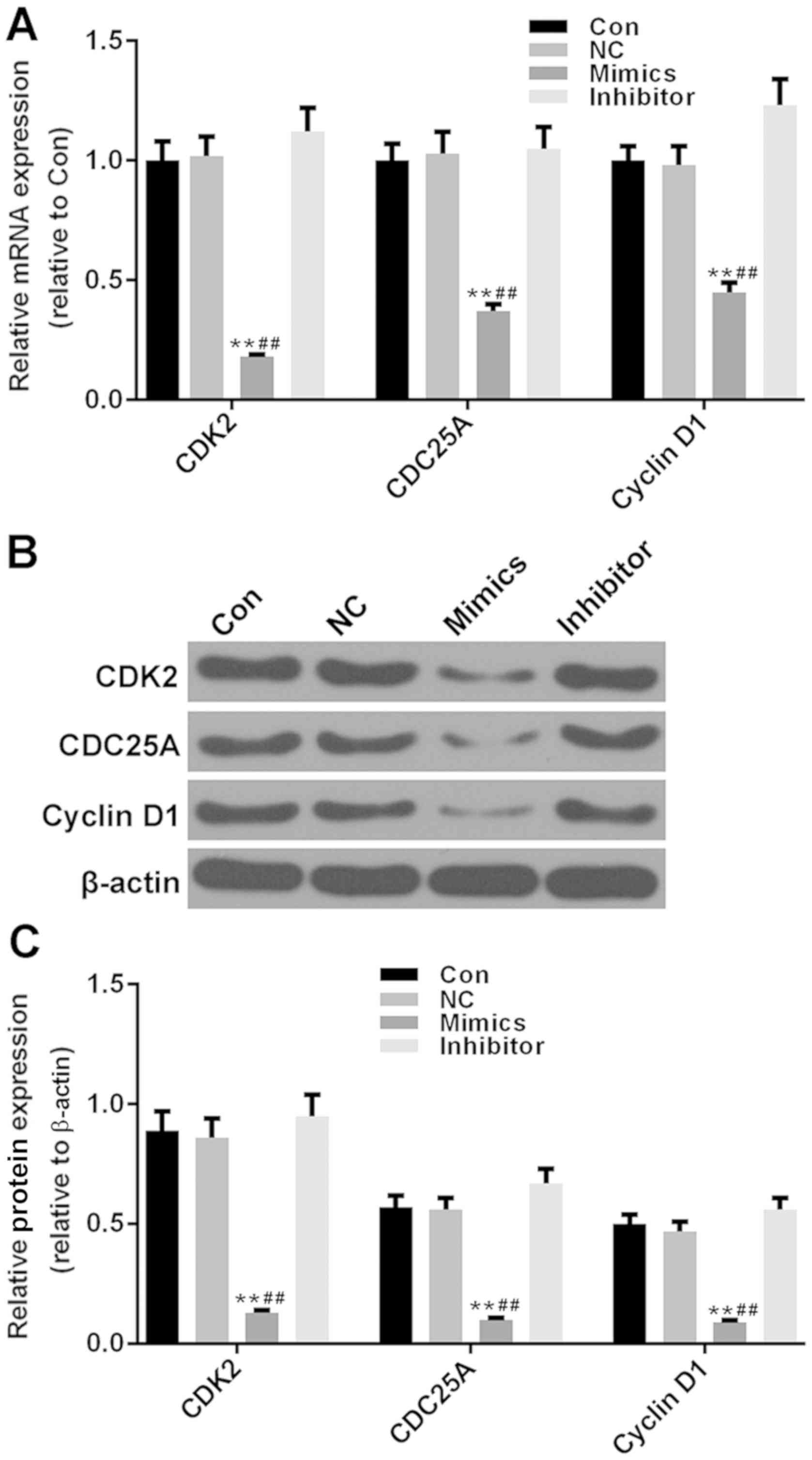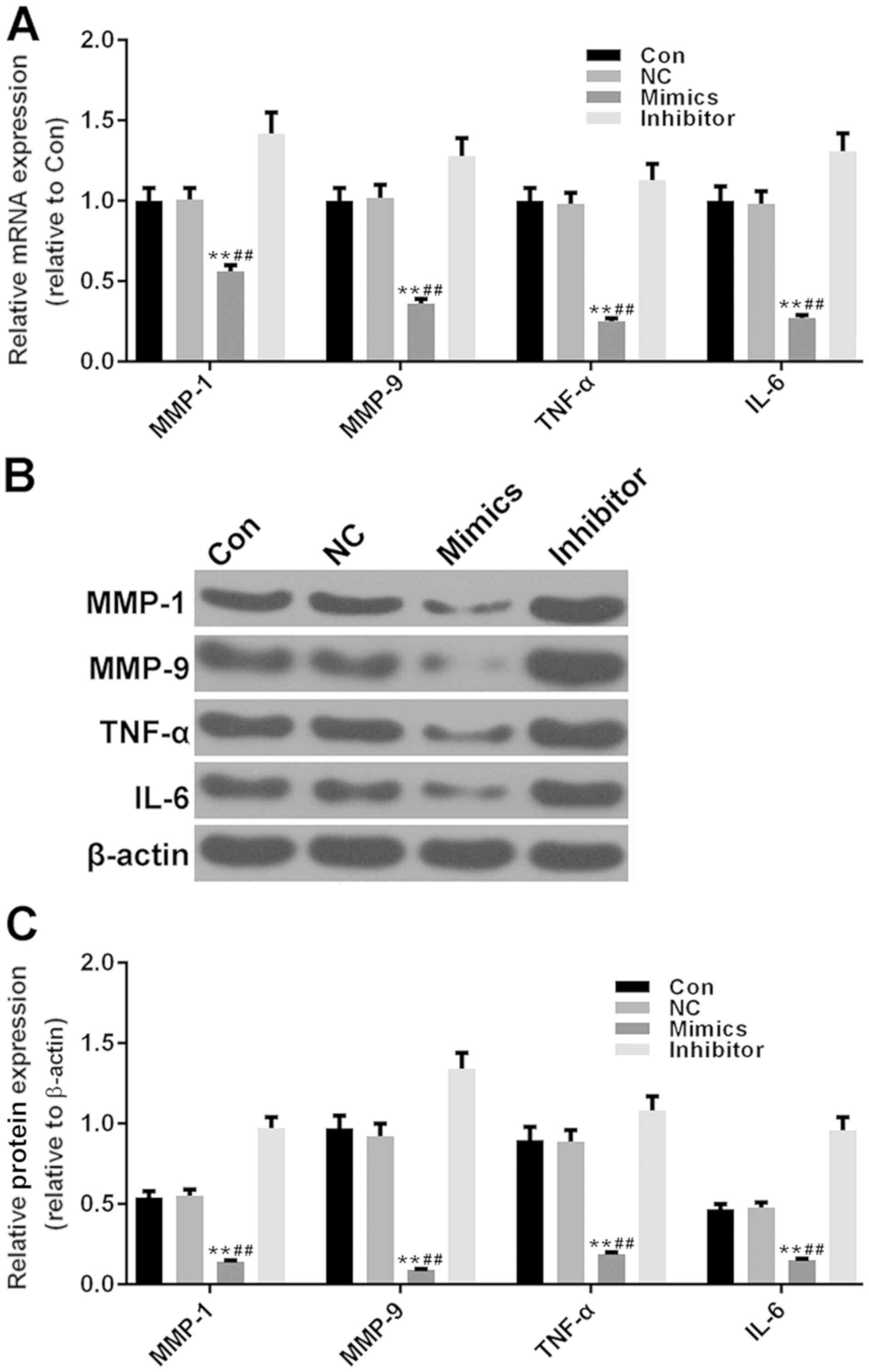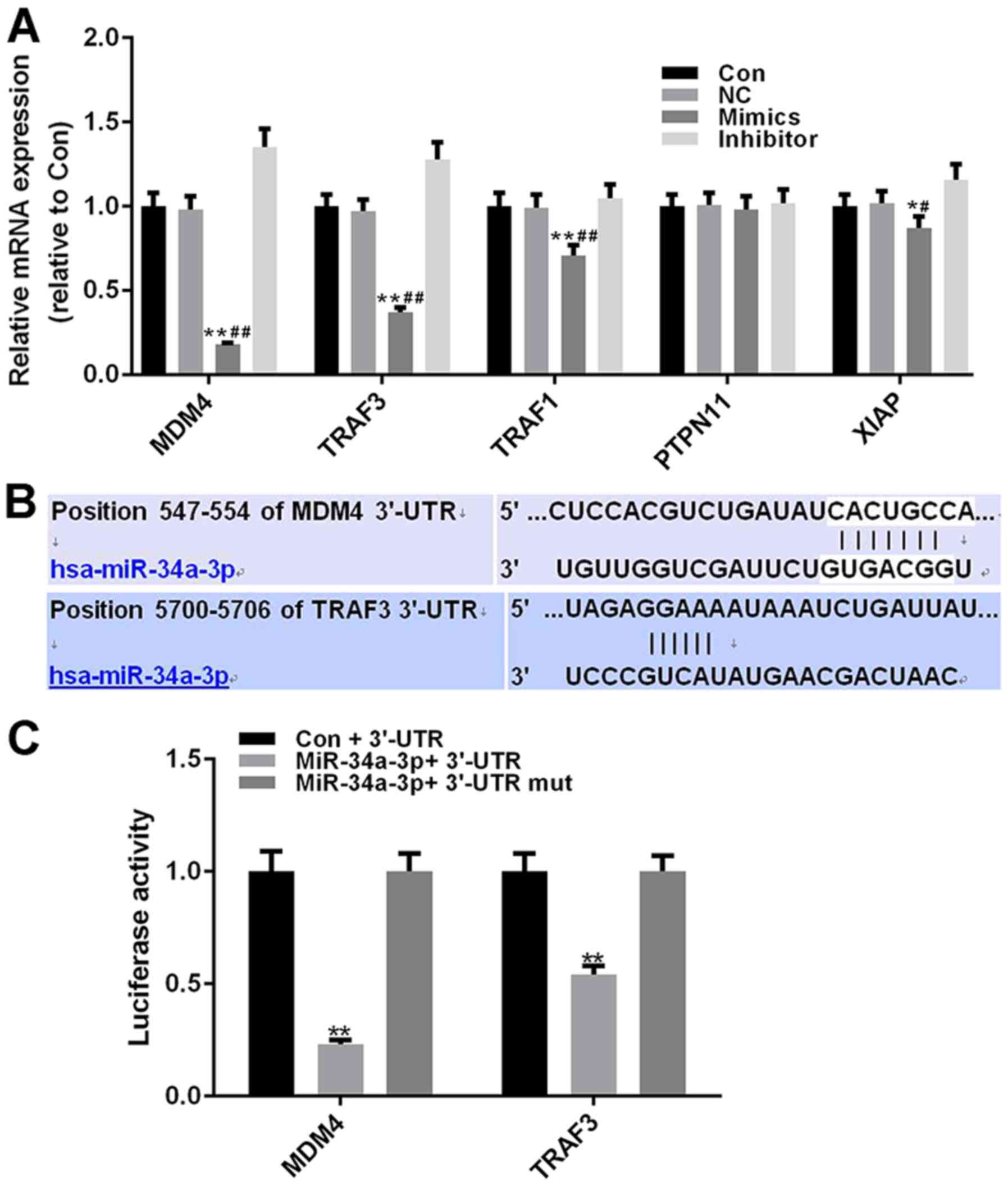|
1
|
Smolen JS, Aletaha D and McInnes IB:
Rheumatoid arthritis. Lancet. 388:2023–2038. 2016. View Article : Google Scholar : PubMed/NCBI
|
|
2
|
Li ZG, Liu Y, Xu HJ, Chen ZW, Bao CD, Gu
JR, Zhao DB, An Y, Hwang LJ, Wang L, et al: Efficacy and safety of
tofacitinib in chinese patients with rheumatoid arthritis. Chin Med
J (Engl). 131:2683–2692. 2018. View Article : Google Scholar : PubMed/NCBI
|
|
3
|
Gibofsky A: Overview of epidemiology,
pathophysiology, and diagnosis of rheumatoid arthritis. Am J Manag
Care. 18:S295–S302. 2012.PubMed/NCBI
|
|
4
|
Hawtree S, Muthana M and Wilson AG: The
role of histone deacetylases in rheumatoid arthritis
fibroblast-like synoviocytes. Biochem Soc Trans. 41:783–788. 2013.
View Article : Google Scholar : PubMed/NCBI
|
|
5
|
Filer A, Ward LSC, Kemble S, Davies CS,
Munir H, Rogers R, Raza K, Buckley CD, Nash GB and McGettrick HM:
Identification of a transitional fibroblast function in very early
rheumatoid arthritis. Ann Rheum Dis. 76:2105–2112. 2017. View Article : Google Scholar : PubMed/NCBI
|
|
6
|
Hirohata S and Sakakibara J:
Angioneogenesis in rheumatoid arthritis. Lancet. 354:423–424. 1999.
View Article : Google Scholar : PubMed/NCBI
|
|
7
|
Danks L, Komatsu N, Guerrini MM, Sawa S,
Armaka M, Kollias G, Nakashima T and Takayanagi H: RANKL expressed
on synovial fibroblasts is primarily responsible for bone erosions
during joint inflammation. Ann Rheum Dis. 75:1187–1195. 2016.
View Article : Google Scholar : PubMed/NCBI
|
|
8
|
Kim HR, Kim KW, Kim BM, Jung HG, Cho ML
and Lee SH: Reciprocal activation of CD4+ T cells and synovial
fibroblasts by stromal cell-derived factor 1 promotes RANKL
expression and osteoclastogenesis in rheumatoid arthritis.
Arthritis Rheumatol. 66:538–548. 2014. View Article : Google Scholar : PubMed/NCBI
|
|
9
|
Jung YK, Kang YM and Han S: Osteoclasts in
the inflammatory arthritis: Implications for pathologic osteolysis.
Immune Netw. 19:e22019. View Article : Google Scholar : PubMed/NCBI
|
|
10
|
Xiao C and Rajewsky K: MicroRNA control in
the immune system: Basic principles. Cell. 136:26–36. 2009.
View Article : Google Scholar : PubMed/NCBI
|
|
11
|
Ruedel A, Dietrich P, Schubert T,
Hofmeister S, Hellerbrand C and Bosserhoff AK: Expression and
function of microRNA-188-5p in activated rheumatoid arthritis
synovial fibroblasts. Int J Clin Exp Pathol. 8:6607–6616.
2015.PubMed/NCBI
|
|
12
|
Tavasolian F, Abdollahi E, Rezaei R,
Momtazi-Borojeni AA, Henrotin Y and Sahebkar A: Altered expression
of microRNAs in rheumatoid arthritis. J Cell Biochem. 119:478–487.
2018. View Article : Google Scholar : PubMed/NCBI
|
|
13
|
Ji JD, Kim TH, Lee B, Na KS, Choi SJ, Lee
YH and Song GG: Integrated analysis of microRNA and mRNA expression
profiles in rheumatoid arthritis synovial monocytes. J Rheum Dis.
18:253–263. 2011. View Article : Google Scholar
|
|
14
|
Dang Q, Yang F, Lei H, Liu X, Yan M, Huang
H, Fan X and Li Y: Inhibition of microRNA-34a ameliorates murine
collagen-induced arthritis. Exp Ther Med. 14:1633–1639. 2017.
View Article : Google Scholar : PubMed/NCBI
|
|
15
|
Niederer F, Trenkmann M, Ospelt C,
Karouzakis E, Neidhart M, Stanczyk J, Kolling C, Gay RE, Detmar M,
Gay S, et al: Down-regulation of microRNA-34a* in rheumatoid
arthritis synovial fibroblasts promotes apoptosis resistance.
Arthritis Rheum. 64:1771–1779. 2012. View Article : Google Scholar : PubMed/NCBI
|
|
16
|
Arnett FC, Edworthy SM, Bloch DA, McShane
DJ, Fries JF, Cooper NS, Healey LA, Kaplan SR, Liang MH, Luthra HS,
et al: The American Rheumatism Association 1987 revised criteria
for the classification of rheumatoid arthritis. Arthritis Rheum.
31:315–324. 1988. View Article : Google Scholar : PubMed/NCBI
|
|
17
|
Bailon-Moscoso N, González-Arévalo G,
Velásquez-Rojas G, Malagon O, Vidari G, Zentella-Dehesa A,
Ratovitski EA and Ostrosky-Wegman P: Phytometabolite
dehydroleucodine induces cell cycle arrest, apoptosis, and DNA
damage in human astrocytoma cells through p73/p53 regulation. PLoS
One. 10:e01365272015. View Article : Google Scholar : PubMed/NCBI
|
|
18
|
Tao K, Yang J, Guo Z, Hu Y, Sheng H, Gao H
and Yu H: Prognostic value of miR-221-3p, miR-342-3p and miR-491-5p
expression in colon cancer. Am J Transl Res. 6:391–401.
2014.PubMed/NCBI
|
|
19
|
Livak KJ and Schmittgen TD: Analysis of
relative gene expression data using real-time quantitative PCR and
the 2(-Delta Delta C(T)) method. Methods. 25:402–408. 2001.
View Article : Google Scholar : PubMed/NCBI
|
|
20
|
Bustamante MF, Garcia-Carbonell R,
Whisenant KD and Guma M: Fibroblast-like synoviocyte metabolism in
the pathogenesis of rheumatoid arthritis. Arthritis Res Ther.
19:1102017. View Article : Google Scholar : PubMed/NCBI
|
|
21
|
Sotillo E, Laver T, Mellert H, Schelter
JM, Cleary MA, McMahon S and Thomas-Tikhonenko A: Myc
overexpression brings out unexpected antiapoptotic effects of
miR-34a. Oncogene. 30:2587–2594. 2011. View Article : Google Scholar : PubMed/NCBI
|
|
22
|
Mudduluru G, Ceppi P, Kumarswamy R,
Scagliotti GV, Papotti M and Allgayer H: Regulation of Axl receptor
tyrosine kinase expression by miR-34a and miR-199a/b in solid
cancer. Oncogene. 30:2888–2899. 2011. View Article : Google Scholar : PubMed/NCBI
|
|
23
|
Zhang W, Chen L, Jiang Y and Shen Y:
miR-26a-5p regulates synovial fibroblast invasion in patients with
rheumatoid arthritis by targeting Smad 1. Med Sci Monit.
24:5178–5184. 2018. View Article : Google Scholar : PubMed/NCBI
|
|
24
|
Audo R, Deckert V, Daien CI, Che H,
Elhmioui J, Lemaire S, Pais de Barros JP, Desrumaux C, Combe B,
Hahne M, et al: PhosphoLipid transfer protein (PLTP) exerts a
direct pro-inflammatory effect on rheumatoid arthritis (RA)
fibroblasts-like-synoviocytes (FLS) independently of its lipid
transfer activity. PLoS One. 13:e01938152018. View Article : Google Scholar : PubMed/NCBI
|
|
25
|
Ruedel A, Dietrich P, Schubert T,
Hofmeister S, Hellerbrand C and Bosserhoff AK: Expression and
function of microRNA-188-5p in activated rheumatoid arthritis
synovial fibroblasts. Int J Clin Exp Pathol. 8:4953–4962.
2015.PubMed/NCBI
|
|
26
|
Jia W, Wu W, Yang D, Xiao C, Su Z, Huang
Z, Li Z, Qin M, Huang M, Liu S, et al: Histone demethylase JMJD3
regulates fibroblast-like synoviocyte-mediated proliferation and
joint destruction in rheumatoid arthritis. FASEB J. 32:4031–4042.
2018. View Article : Google Scholar : PubMed/NCBI
|
|
27
|
Bačević K, Lossaint G, Achour TN, Georget
V, Fisher D and Dulić V: Cdk2 strengthens the intra-S checkpoint
and counteracts cell cycle exit induced by DNA damage. Sci Rep.
7:134292017. View Article : Google Scholar : PubMed/NCBI
|
|
28
|
Sherr CJ, Beach D and Shapiro GI:
Targeting CDK4 and CDK6: From discovery to therapy. Cancer Discov.
6:353–367. 2016. View Article : Google Scholar : PubMed/NCBI
|
|
29
|
Zhou H, Shen T, Luo Y, Liu L, Chen W, Xu
B, Han X, Pang J, Rivera CA and Huang S: The antitumor activity of
the fungicide ciclopirox. Int J Cancer. 127:2467–2477. 2010.
View Article : Google Scholar : PubMed/NCBI
|
|
30
|
Li F, Li X, Kou L, Li Y, Meng F and Ma F:
SUMO-conjugating enzyme UBC9 promotes proliferation and migration
of fibroblast-like synoviocytes in rheumatoid arthritis.
Inflammation. 37:1134–1141. 2014. View Article : Google Scholar : PubMed/NCBI
|
|
31
|
Yuan H, Yang P, Zhou D, Gao W, Qiu Z, Fang
F, Ding S and Xiao W: Knockdown of sphingosine kinase 1 inhibits
the migration and invasion of human rheumatoid arthritis
fibroblast-like synoviocytes by down-regulating the PI3K/AKT
activation and MMP-2/9 production in vitro. Mol Biol Rep.
41:5157–5165. 2014. View Article : Google Scholar : PubMed/NCBI
|
|
32
|
Mo WX, Yin SS, Chen H, Zhou C, Zhou JX,
Zhao LD, Fei YY, Yang HX, Guo JB, Mao YJ, et al: Chemotaxis of Vδ2
T cells to the joints contributes to the pathogenesis of rheumatoid
arthritis. Ann Rheum Dis. 76:2075–2084. 2017. View Article : Google Scholar : PubMed/NCBI
|
|
33
|
Wei ST, Sun YH, Zong SH and Xiang YB:
Serum levels of IL-6 and TNF-α may correlate with activity and
severity of rheumatoid arthritis. Med Sci Monit. 21:4030–4038.
2015. View Article : Google Scholar : PubMed/NCBI
|
|
34
|
Guo Q, Wang Y, Xu D, Nossent J, Pavlos NJ
and Xu J: Rheumatoid arthritis: Pathological mechanisms and modern
pharmacologic therapies. Bone Res. 6:152018. View Article : Google Scholar : PubMed/NCBI
|
|
35
|
Nishina N, Kaneko Y, Kameda H, Kuwana M
and Takeuchi T: Reduction of plasma IL-6 but not TNF-α by
methotrexate in patients with early rheumatoid arthritis: A
potential biomarker for radiographic progression. Clin Rheumatol.
32:1661–1666. 2013. View Article : Google Scholar : PubMed/NCBI
|
|
36
|
Siegfried G, Basak A, Cromlish JA,
Benjannet S, Marcinkiewicz J, Chrétien M, Seidah NG and Khatib AM:
The secretory proprotein convertases furin, PC5, and PC7 activate
VEGF-C to induce tumorigenesis. J Clin Invest. 111:1723–1732. 2003.
View Article : Google Scholar : PubMed/NCBI
|
|
37
|
Abdollahzad H, Aghdashi MA, Asghari
Jafarabadi M and Alipour B: Effects of coenzyme Q10 supplementation
on inflammatory cytokines (TNF-α, IL-6) and oxidative stress in
rheumatoid arthritis patients: A randomized controlled trial. Arch
Med Res. 46:527–533. 2015. View Article : Google Scholar : PubMed/NCBI
|
|
38
|
Kim GW, Lee NR, Pi RH, Lim YS, Lee YM, Lee
JM, Jeong HS and Chung SH: IL-6 inhibitors for treatment of
rheumatoid arthritis: Past, present, and future. Arch Pharm Res.
38:575–584. 2015. View Article : Google Scholar : PubMed/NCBI
|
|
39
|
Xu N, Wang Y, Li D, Chen G, Sun R, Zhu R,
Sun S, Liu H, Yang G and Dong T: MDM4 overexpression contributes to
synoviocyte proliferation in patients with rheumatoid arthritis.
Biochem Biophys Res Commun. 401:417–421. 2010. View Article : Google Scholar : PubMed/NCBI
|
|
40
|
Kurowska-Stolarska M, Alivernini S,
Melchor EG, Elmesmari A, Tolusso B, Tange C, Petricca L, Gilchrist
DS, Di Sante G, Keijzer C, et al: MicroRNA-34a dependent regulation
of AXL controls the activation of dendritic cells in inflammatory
arthritis. Nat Commun. 8:158772017. View Article : Google Scholar : PubMed/NCBI
|
|
41
|
Jiang L, Huang Q, Zhang S, Zhang Q, Chang
J, Qiu X and Wang E: Hsa-miR-125a-3p and hsa-miR-125a-5p are
downregulated in non-small cell lung cancer and have inverse
effects on invasion and migration of lung cancer cells. BMC Cancer.
10:3182010. View Article : Google Scholar : PubMed/NCBI
|
|
42
|
Córdova-Rivas S, Fraire-Soto I,
Mercado-Casas Torres A, Servín-González LS, Granados-López AJ,
López-Hernández Y, Reyes-Estrada CA, Gutiérrez-Hernández R,
Castañeda-Delgado JE, Ramírez-Hernández L, et al: 5p and 3p strands
of miR-34 family members have differential effects in cell
proliferation, migration, and invasion in cervical cancer cells.
Int J Mol Sci. 20:2019. View Article : Google Scholar
|



